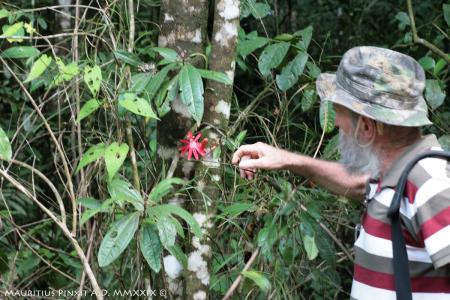
SUBGENUS: passiflora
SUPERSECTION: distephana
GEOGRAPHICAL DISTRIBUTION OR ORIGIN:
Guyane.
MINIMUM TEMPERATURE: 15 °C
IDEAL MINIMUM TEMPERATURE: 20 °C
SYNONYMS: P. imthurnii Mast., P. silvicola Barb. Rodr.
ETYMOLOGY: This species is rich in nectariferous glands (Lat. glandulosus)
NOTES: Chromosomes: n=9, 2n=18
DESCRIPTION:
The flora of French Guiana, which abounds in passionflowers, some still to be discovered, is dominated by this beautiful and imposing climber with red flowers. It is almost always a different red from that typical of supersection Distephana as we are used to seeing it, in the forms of P. coccinea, P. vitifolia and P. quadrifaria. It is in fact a colour that cannot always be defined as pure red, as it is often a dominant shiny, bright pink.
The shape of the flower is also different. The large corolla (11-12 cm in diameter) is dominated by hooked sepals and narrow, slender oblong petals, slightly retroflexed. The centre of the flower is small in diameter offering a maximum degree of elegance. The small corona is composed of two series of sparse, short white filaments with a dark base. The rich, abundant flowers create splashes of bright colour amidst the dark green of the forest.
The very dark green leaves are leathery, like those of most Guyanese passionflowers, and ovate-oblong with a narrow, sharp apex.
The fruit is ovoid and 6 cm in diameter.
This tropical passionflower always requires high temperatures (> 15°C) and is difficult to adapt to growing in pots. Up until now, attempts to see it flourish in Italy have been disappointing. It does not tolerate the lime in water used for watering (which, however, must not be too frequent), nor the usual multipurpose soil that generally gives good results in other species. It, therefore, requires further study to discover its actual ability to acclimatise to life in the greenhouse.
It is not difficult to reproduce from seed and propagate from cuttings; nevertheless, a high percentage of the specimens obtained are lost.